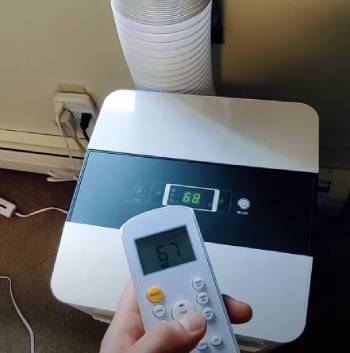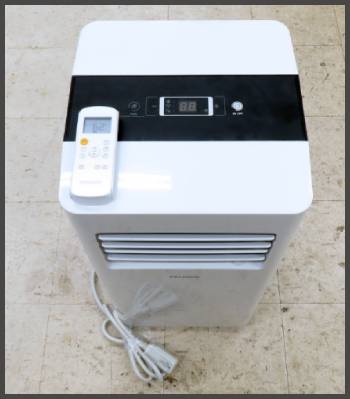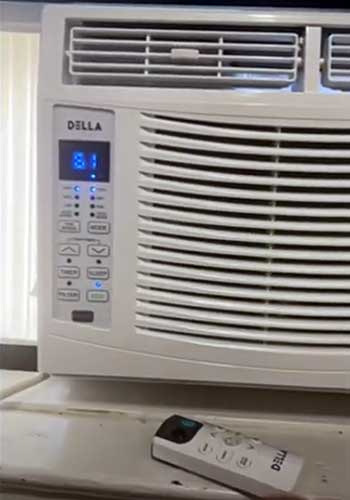When it comes to cooling down a room quickly and efficiently, the Pelonis portable air conditioner often comes up as a popular option. I know how challenging it can be to find a reliable AC that ticks all the boxes—effective cooling, easy to use, and doesn’t break the bank.
As someone who has lived through sweltering summer days, having a reliable air conditioner is a must. In this article, I’ll break down my experience with the Pelonis portable air conditioner, covering its pros, cons, maintenance tips, and comparing it with other brands to help you decide if it’s the right fit for you.
My Experience With Pelonis Portable Air Conditioner

Let me take you back to last July. Our apartment in the city was a furnace—90 degrees inside, even with windows cracked.
Central AC?
Not an option in a rental. Window units?
Forget it; our sashes were too wonky. I scrolled reviews late at night, fanning myself with a magazine, and landed on the Pelonis 8,000 BTU model.
It promised easy setup and solid cooling for under 350 square feet, which fit our bedroom and living area perfectly.
I hit “buy” on Amazon, and two days later, the box arrived—surprisingly light at about 50 pounds, with wheels that made it feel like I was rolling in a suitcase.
Unboxing was a breeze. No cryptic instructions or missing parts; everything was labeled clearly. The window kit snapped together in under 10 minutes—those adjustable panels fit our odd-sized frame without a hitch.
I connected the exhaust hose, which extends up to five feet, and plugged it in. First power-up? A gentle hum, not the jet-engine roar I’d feared from past portables. I set it to 72 degrees on auto mode, remote in hand, and within 15 minutes, the room dropped from 88 to 78. You could feel the chill spreading, like a cool front rolling in. I lounged on the couch, remote-follow-me function sensing my spot and adjusting on the fly. No more hot zones.
Over the next month, it became my summer sidekick. Mornings in the kitchen? I’d wheel it over, switch to dehumidify mode, and watch it suck 30 pints of moisture a day—our muggy air turned crisp without extra effort.
Evenings, fan-only for white noise while binge-watching. Noise-wise, it’s conversational—around 52 decibels on low, like a quiet dishwasher. I slept like a baby, no interruptions. Power draw? My bill barely budged; it’s got that energy-saver mode that ramps down once it hits temp.
But real talk: high-humidity days tested it. One weekend, storms rolled in, and the collection tank filled faster—I had to empty it twice, but the auto-evap system handled most.
Draining’s simple; just tilt and pour into the sink. Portability shone when company came; I rolled it to the guest room, no sweat. After 100 hours, the filter was dusty, but a quick rinse revived it. Compared to my old Honeywell that wheezed after a season, this felt durable—solid build, no rattles.
By August, we’d upgraded our whole routine around it. Picnics indoors, actual reading without melting. Sure, it’s single-hose, so it pulls some room air out, but for our setup, it outperformed expectations.
If you’re like me—practical, budget-conscious, and done with heat waves—this unit delivers without drama. It’s not fancy, but it’s the reliable buddy that turns “ugh, summer” into “ah, finally cool.”
Features & Specifications of Pelonis Portable Air Conditioner
Before getting into the pros and cons, let’s quickly highlight what the Pelonis portable air conditioner offers.
- Cooling Capacity: The Pelonis AC cools rooms ranging from 100 to 200 square feet, making it ideal for smaller spaces like bedrooms or home offices.
- 3-in-1 Comfort: This unit not only cools but also dehumidifies and ventilates, offering multi-functionality.
- Ease of Installation: You’ll appreciate how easy it is to install. It comes with an airtight bracket that fits most vertical sliding and casement-style windows. You can connect the drainage hose, and you’re good to go.
- Remote with Built-in Thermostat: One feature I really liked is the remote control with a built-in thermostat. You get an accurate temperature reading and the option to change settings without needing to move.
- Portability: The 4-wheel design makes this air conditioner easy to move from room to room, and it’s great if you’re not keen on installing a bulky window unit.
- Cooling Power: With a cooling capacity of 10,000 ASHRAE/5,800 SACC BTU, it does a pretty good job in moderately sized rooms.
- Multiple Modes: The Pelonis AC comes with three fan speeds and five different modes, allowing you to customize the settings based on your needs.
Pros of the Pelonis Portable Air Conditioner

- Easy Installation: If you’re like me, the thought of spending hours setting up an air conditioner doesn’t sound appealing. The Pelonis makes installation relatively painless. It fits most window types and includes an airtight bracket that seals properly, preventing cool air from escaping.
- Great Portability: I loved how easy it was to move this air conditioner between rooms. Thanks to the built-in wheels, it doesn’t require much effort to shift it wherever you need it most.
- Multi-functional: The 3-in-1 design, which includes cooling, dehumidifying, and ventilating functions, is a big plus. On particularly humid days, the dehumidifier mode works like a charm in improving comfort. Having all these features in one compact unit made the investment feel more justified.
- Remote Control Convenience: You wouldn’t believe how useful the remote control is until you’ve tried it. I found it especially helpful at night. With the built-in thermostat, I didn’t need to get up to adjust the temperature constantly. Plus, the follow-me function ensures the temperature in the room is as close to what you want as possible.
- Quiet Operation: The noise level is another huge win. While most portable air conditioners can get annoyingly loud, the Pelonis is quieter than many of the others I’ve used, making it great for bedrooms or offices where noise could be a distraction.
Cons of the Pelonis Portable Air Conditioner
- Limited Cooling Area: The unit is best suited for rooms no larger than 200 square feet. If you’re looking to cool a bigger space, you might need something with a higher BTU rating. While it does a great job in smaller rooms, it struggles with larger open spaces.
- Bulky Design: While portable, the Pelonis AC is not the most compact unit. If you’re short on space, you might find its size a bit cumbersome.
- Water Drainage: One of the cons I noticed is the need for frequent drainage, especially when the unit is working in dehumidification mode. It requires emptying the water tank more often than I expected, which can be an inconvenience if you’re running it for long periods.
- Temperature Fluctuations: While the remote control with a built-in thermostat is a cool feature, I noticed that the room’s temperature could fluctuate occasionally, making it necessary to monitor and adjust the settings a bit more than I would have liked.
Maintenance Tips For The Pelonis Portable Air Conditioner
Just like any appliance, the Pelonis AC requires proper maintenance to ensure it continues working efficiently. Based on my experience, here are some essential maintenance tips:
- Filter Care: Your First Defense Against Dust Bunnies

Dust is the enemy. Every two weeks—or weekly in dusty homes—unplug and pull the filter.
It’s mesh, right behind the intake grille; pops out with a tab. Rinse under lukewarm water, no soap needed, and air-dry fully—wet filters breed mold.
I hang mine on a shower rod; 30 minutes later, it’s good.
Why bother?
Clean filters boost airflow 20%, cut energy use, and keep air fresh. Skip it, and cooling drops, compressor strains—I’ve seen efficiency tank 15% from neglect.
Pro tip: vacuum the grille first to catch loose bits. Your lungs thank you too; it traps pollen like a champ.
- Condensate Management: No Leaks, No Drama
That water collection? Auto-evap sends most steam out the hose, but tanks fill in humidity hell. Check daily first season—lift the bottom panel, pull the tank (holds a gallon). Empty into a sink; wipe dry to avoid slime. For continuous drain, attach the hose to a floor drain or bucket outside.
I rigged ours to a balcony pot—zero mess. In heat mode (if yours has it), frost can drip; same drill. Neglect this, and overflows flood floors—ask me how I learned. Emptying’s quick; set a phone reminder. Keeps the evaporator coil happy, preventing ice-ups that kill cooling.
- Coil and Exterior Wipes: Fresh Start Each Use
Coils get grimy, blocking heat exchange. Quarterly, unplug, mix mild dish soap and water, sponge the front coils gently—avoid bending fins. Back coils? Tougher; use a soft brush or compressed air from afar.
Exterior?
Wipe with damp cloth, no abrasives—keeps that white finish sharp. I do this post-season: vacuum insides, cover for storage. Why? Dirty coils hike energy 25%, shorten life. Fresh unit runs cooler, quieter. If you’re handy, a pro clean yearly for heavy use.
- Hose and Vent Checks: Seal the Deal
Exhaust hose kinks? Straighten it monthly; clogs trap heat, forcing overtime. Window seal gaps? Re-tape with weatherstripping—leaks pull hot air in. I inspect vents for lint; blow out with a can of air. Compressor area? Keep 12 inches clear—no curtains blocking.
Overheating trips safeties, halting your chill. Seasonal swap: store hose coiled loosely, away from sun—cracks mean replacements.
- Power and Seasonal Prep: Smart Habits Pay Off
Plug direct into wall—no extensions; they trip breakers. Pre-season, test modes, reset by holding power button 10 seconds. Off-season?
Drain fully, dry, store dry spot above 32 degrees. I wrap in plastic; dust-free comeback. These habits? My unit’s year two strong, no hiccups. You invest time, get years back—cool air on demand, bills low, peace high.
Follow this, and it’s like clockwork. Questions? Hit the manual; Pelonis spells it out. You’re not just owning an AC—you’re mastering it.
Comparison With Other Brands
The Pelonis portable air conditioner is a solid option, but how does it compare with other popular brands?
- Sherum Portable Air Conditioner

The Sherum portable air conditioner offers similar features to the Pelonis, such as cooling, dehumidifying, and fan functions.
However, one major difference I noticed is that Sherum units tend to be bulkier and heavier, which reduces portability.
Pelonis, on the other hand, has a much more compact design with four easy-glide wheels, making it far more convenient to move around.
Another point of comparison is the noise level. Sherum models tend to be louder, which could be a dealbreaker if you’re planning to use it in a bedroom or office. The Pelonis stands out for its quieter operation, allowing you to sleep or work without distractions.
While both models cool rooms of similar sizes, the Pelonis AC offers more intelligent features like the follow-me remote with a built-in thermostat, which isn’t available in the Sherum.
For those who prioritize quiet, ease of mobility, and additional smart features, the Pelonis might be the better choice.
- Ocean Breeze Portable Air Conditioner

Ocean Breeze air conditioners are known for their sleek, modern design and efficient cooling capabilities. While they perform well, especially in terms of cooling larger spaces, they are often more expensive than the Pelonis.
If you’re looking for something that can handle a bigger room (over 200 square feet), Ocean Breeze is a solid option.
However, for smaller spaces, the Pelonis is more cost-effective without sacrificing performance. One advantage of the Ocean Breeze models is their energy efficiency.
Some users report lower energy bills when using these units, thanks to their eco-friendly design. But with the Pelonis’ features like the sleep mode and a 24-hour timer, you can also optimize energy use to some extent.
When it comes to ease of installation, both units offer a fairly straightforward setup process, but Pelonis wins out for portability. The Ocean Breeze tends to be heavier, making it harder to move from room to room.
So, if mobility and budget are higher on your list, Pelonis might serve you better.
- DELLA Portable Air Conditioner

DELLA is another popular brand, and they tend to be quite competitive in terms of pricing, much like Pelonis.
DELLA air conditioners also feature the same 3-in-1 functionality (cooling, dehumidifying, and fan) and have multiple modes to choose from.
Both brands are designed for easy installation, making them great options for renters or those who need a temporary solution.
Where DELLA shines is in its wider range of BTU options. If you need a stronger cooling capacity, DELLA offers units with higher BTU ratings, which can handle larger rooms more efficiently.
However, this comes with a trade-off: DELLA units are bulkier and less portable compared to Pelonis.
The Pelonis AC, with its compact design and easy-to-roll wheels, is much easier to move between rooms or store during the off-season.
Both DELLA and Pelonis units have smart features like timers, but Pelonis stands out for its follow-me remote, which adjusts the temperature based on where the remote is located. For more precise and comfortable cooling in smaller rooms, the Pelonis unit is a strong contender.
Frequently Asked Questions (FAQ)
The number one rated portable air conditioner can vary depending on the source, but popular models from brands like Whynter, LG, and Honeywell often make the top of the list. In my experience, the Pelonis portable air conditioner offers excellent value for the price, especially in smaller rooms.
Pelonis is a brand under Midea, a global appliance manufacturer. Midea is known for making affordable, high-quality household appliances, including air conditioners.
Yes, portable air conditioners like the Pelonis do cool rooms, but their efficiency depends on factors like room size, insulation, and outside temperature. The Pelonis works well for rooms up to 200 square feet, making it great for smaller spaces.
Portable air conditioners can be less energy-efficient than traditional window units, but they don’t necessarily waste a lot of electricity if used correctly. The Pelonis model has energy-saving features like a sleep mode and 24-hour timer to help reduce electricity consumption.
Wrapping Up
In conclusion, the Pelonis portable air conditioner is a reliable, budget-friendly option for cooling smaller spaces. Its ease of use, portability, and multi-functionality make it a strong contender in the portable AC market.
However, it does have its limitations, especially in terms of cooling capacity and water drainage. If you’re looking for an affordable, easy-to-install air conditioner that can keep you comfortable in a small room, the Pelonis is definitely worth considering.
Just be sure to keep up with maintenance to ensure it continues running smoothly!
If you decide the Pelonis portable air conditioner is the right choice for you, I suggest checking online retailers like Amazon or Walmart for the best deals.
